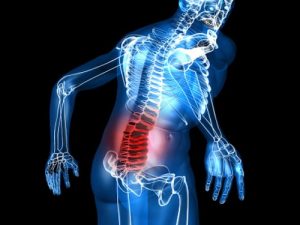 Lumbar radiculitis is a type of back pain that’s felt in the lower part of the back and originates from the spine. A more precise lumbar radiculitis definition would be nerve root pain in the lower part of the spine, referred to as the lumbar region. The term radiculitis is pain that radiates along a sensory distribution (dermatome) of a nerve caused by inflammation or irritation of a nerve root at its connection to the spinal column.
Lumbar radiculitis is a type of back pain that’s felt in the lower part of the back and originates from the spine. A more precise lumbar radiculitis definition would be nerve root pain in the lower part of the spine, referred to as the lumbar region. The term radiculitis is pain that radiates along a sensory distribution (dermatome) of a nerve caused by inflammation or irritation of a nerve root at its connection to the spinal column.
Causes of lumbar radiculitis
The spinal cord has several nerve roots that come out of it from both sides, controlling functions such as our sensory and motor actions. Nerves located at the level of the lumbar spine are known for innervating the areas of the back and lower extremities. The spine is comprised of a protective vertebral column that houses spinal nerves that emerge from spaces between the bony arches of the vertebra. Vertebral columns are named according to what section they come from, which are as follows: cervical (neck), thoracic (chest), Lumbar (abdominal), sacral (pelvic), and Coccygeal (tailbone).
Advertisement
Pathological processes that compromise the integrity of lumbar spinal nerves may lead to the development of lumbar radiculitis. This is not an independent disease, but rather a secondary complication. The following are some conditions that are known for being lumbar radiculitis causes.
Spinal disc herniation is the most common cause of lumbar radiculitis. Disc herniation of an intervertebral disc is characterized by a bulging or protrusion of the soft central portion outside of its protective rings. This leads the space between two spinal discs to be reduced. Different types of nerve pain are determined by which nerves are affected. Spinal disc herniation is usually due to age-related degeneration of the outer spinal ring, known as annulus fibrosus. However, lifting injuries, trauma, and straining have also been known to cause disc herniation as well.
Other causes of lumbar radiculitis include:
- Spine injuries
- Tumors of peripheral nervous system
- Chronic arthritis
- Inflammatory processes
- Metabolic disorders
- Autoimmune pathologies
- Hereditary predisposition
Symptoms of lumbar radiculitis
The lumbar spine is comprised of five lumbar vertebrae that help support body weight as well as promote movement. Several different nerves innervate regions of the lower back and lower extremities that run through the lumbar spine, so depending on the exact location of the injury, symptoms may vary from patient to patient.
The most common form of radiculitis is a condition called sciatica, which occurs due to the compression of the sciatic nerve. This condition affects the lower back, buttocks, legs, and feet, and is most commonly referred to as sciatica pain. Pain in this region is most often described as being sharp in nature and may last a few minutes or as long as the whole day.
Regardless of the location of the injury, the common pain can become aggravated with sharp movements of the lumbar region, fall injuries, heavy lifting, and any physical activity that involves moving your waist. Lumbar radiculopathies can often be exacerbated by coughing, sneezing, and the tensing of the stomach muscles. Because of this, individuals affected often have restricted movement accompanied by muscle weakness and possible tingling and numbness.
Related: What causes burning back pain?
Diagnosis for lumbar radiculitis
A thorough medical examination will be required to accurately diagnose lumbar radiculitis and to rule out any other potential lower back pain causes. Your doctor will look for the tell-tale signs of radiating nerve pain and investigate possible causes for lumbar nerve compression.
During the physical exam, your doctor may ask you to perform simple movements, such as lifting your leg to a certain height. Experiencing pain during this move is a positive sign of lumbar radiculitis
A series of imaging tests will be done, including CT and MRI scans, looking for signs of disc herniation. Additionally, the conduction ability of nerve tissue may also be assessed through an electromyography test, which can accurately determine if a particular nerve has been damaged.
Treatment for lumbar radiculitis
Advertisement
Treatment consists of conservative treatment, pain management, and the possibility of surgery. In most cases, the cause of lumbar radiculopathy will resolve spontaneously over weeks to months. For this reason, most experts simply advise avoiding stress on the lumbar spine and rest. Pain medication is often prescribed to alleviate acute pain and allows the patient to begin exercising and stretching. Surgery is often reserved as a last resort in cases of debilitating pain or loss of function.
The following are the most commonly indicated treatment recommendations:
- Education on suitable body mechanics
- Physical therapy
- Non-steroidal anti-inflammatory drugs (NSAIDs)
- Weight control
- Spinal manipulation: Articulations of the spinal bones
Related: How to use essential oils for back pain relief
